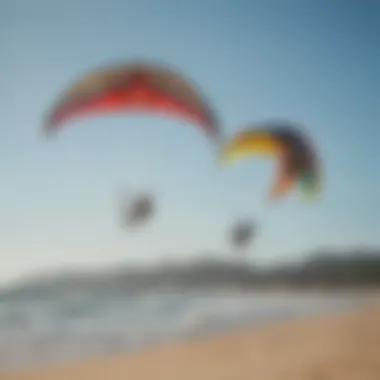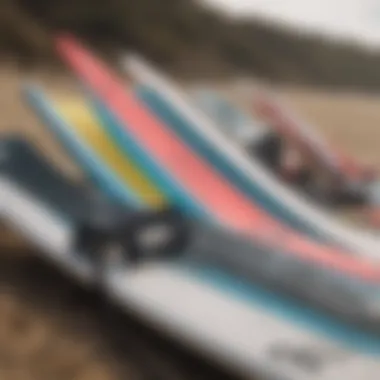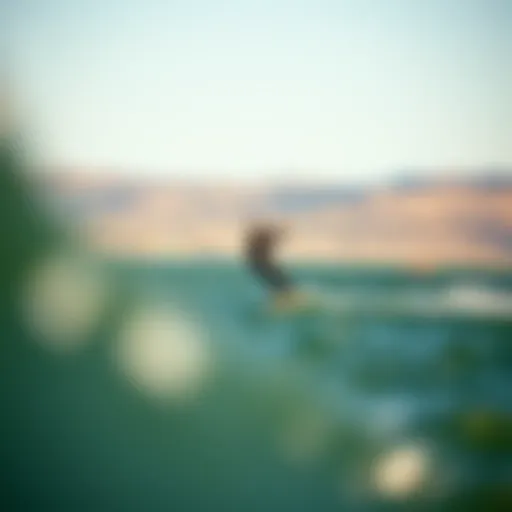Essential Kiteboarding Gear for Every Rider


Intro
Kiteboarding, an exhilarating mix of surfing and flying, has grown in popularity over the years, attracting not only adrenaline junkies but also those seeking a unique way to connect with nature. At the heart of this sport lies the equipment that enables riders to glide over water and catch the wind's power. However, with a myriad of options available on the market, choosing the right gear can feel as daunting as it is thrilling.
In this article, we’ll break down the essential components of kiteboarding equipment, from kites and boards to harnesses and safety gear. Whether you’re a novice eager to catch your first wave or a seasoned pro looking to refine your skills, this guide is tailored for all levels of enthusiasts. We’ll delve into the latest gear reviews, highlight must-haves for beginners, and provide insight into advanced techniques and safety practices most kiteboarders should know.
Understanding the nuances of each piece of equipment is key to enriching your kiteboarding experience, allowing you to ride the wind with confidence. Let’s embark on this journey into the gear that makes kiteboarding not just a sport but an adventure.
Gear Insights
When it comes to kiteboarding, selecting the right gear is fundamental. The equipment serves not just to support your ride but also plays a crucial role in ensuring your safety while maximizing your performance.
Latest Gear Reviews
As the market for kiteboarding gear evolves rapidly, new products emerge that promise to enhance performance and enjoyment. Here are some highlights:
- North Kiteboarding Zeno: Known for its stability and power, the Zeno kite has garnered praise for its responsive handling, making it an excellent choice for all skill levels.
- Slingshot Misfit Board: This board is versatile, offering great pop and control even in choppy waters. It's ideal for both free riding and tricks.
- Brunotti Revo Harness: A comfortable harness that provides excellent back support while allowing freedom of movement.
Essential Gear for Beginners
For those just spreading their wings in kiteboarding, having the right gear is essential for a positive learning experience. Consider these key items:
- Kite: A beginner-friendly kite should be stable and easy to relaunch, such as the Duotone Neo.
- Board: Look for a larger board that provides buoyancy to help you get started without sinking.
- Safety Gear: A helmet and impact vest are vital, offering protection as you navigate the learning curve.
"Choosing the right gear not only enhances your performance but also ensures your safety while learning. Don’t skimp on safety equipment!"
Techniques and Tips
Once you've got your gear sorted, it’s time to master the techniques that will let you ride like the wind.
Advanced Tricks and Techniques
For those looking to elevate their kiteboarding skills, understanding some key tricks can make a world of difference. A few to consider include:
- Jumping: Timing your pop and using your kite to lift you off the water.
- Downloops: A thrilling maneuver that can add speed and boost to your jumps.
- Handle Pass: A trick where you pass the bar behind your back while airborne.
Safety Practices for Kiteboarders
Safety should always be a priority in kiteboarding. Here are fundamental practices to consider:
- Always conduct a pre-flight check of your equipment to ensure everything is in proper working order.
- Stay aware of your surroundings; avoid crowded areas and be mindful of wind conditions.
- Practice self-rescue techniques to ensure you can safely handle any unexpected situations.
In summary, the world of kiteboarding is as vast as the ocean itself. With the right knowledge about gear selection, techniques, and safety, you can navigate this exhilarating sport confidently.
Intro to Kiteboarding Equipment
In the whimsical world of kiteboarding, the right equipment serves as the backbone of your adventure. This section sets the stage for understanding the essential gear that every kiteboarder—whether a novice or a seasoned wind warrior—needs to elevate their experience. The importance of exploring kiteboarding equipment goes beyond just knowing what’s available; it's about figuring out the equipment that resonates with your individual style and skill level, leading to enhanced performance and safety on the water.
The Essence of Kiteboarding Gear
Kiteboarding gear is not merely a collection of items; it’s an ensemble that harmonizes the thrill of the waves with personal expression. When looking at the essence of kiteboarding gear, you’ll find that it encompasses kites, boards, harnesses, control bars, and other components that facilitate the kiteboarder's journey.
Kites come in a variety of shapes and sizes, each tailored to specific wind conditions and riding styles. Boards offer distinct characteristics, such as lightness and buoyancy, impacting how you glide across the surface. Each piece of gear can often be a game changer, and understanding these elements helps to establish a strong foundation.
However, it’s not just about choosing the finest items; it’s also crucial to ensure the gear aligns with your body type and riding style. For instance, someone who enjoys a more aggressive, freestyle approach might opt for a smaller kite that allows for quick maneuverability, while a person soaking up the rays in flat water might lean towards a larger kite that delivers solid lift. The synergy arising from this connection between rider and equipment is the path to mastery.
Market Trends in Kiteboarding Equipment
In recent years, the kiteboarding market showcases an evolution driven by technological advancements and shifting consumer preferences. Manufacturers are increasingly drawing on insights from riders around the globe to craft gear that meets diverse needs. A noticeable trend is the emphasis on eco-friendly materials. As awareness of environmental issues grows, players in this space are prioritizing sustainable production practices without compromising performance. For instance, kiteboards crafted from recycled materials are making waves, appealing to eco-conscious riders.
Another trend to watch is the rise of smart technology integration. Kites with enhanced responsiveness and built-in indicators for wind conditions are gaining traction. Ride-smart features offer valuable data that guide users in selecting optimal setup configurations according to terrain and weather changes.
With all these options on the market, potential buyers need to stay updated on new product launches and innovations. Engaging in online forums, such as Reddit, can provide insights from experienced kiteboarders who share their firsthand experiences with the latest gear. Additionally, checking out platforms like Facebook can connect you with local kiteboarding communities that discuss upcoming trends and equipment sales.
Understanding these trends is key for anyone looking to invest in kiteboarding equipment. It not only broadens the potential choices available but also arms you with knowledge to make informed decisions when navigating the bustling marketplace.


Types of Kiteboarding Equipment
Understanding the different types of kiteboarding equipment is crucial for both new and experienced riders. Each piece of gear serves a specific purpose, shaping the overall experience on the water. The right gear has the potential to enhance performance, safety, and fun. Whether you're aiming for smooth glides across the surface or heighten your skills, the equipment you choose plays a pivotal role.
Kites: Varieties and Specifications
Different Kite Shapes
Kite shapes vary widely, and each design has its own advantages and disadvantages. Common shapes include C-kites, bow kites, and delta kites. C-kites, for example, are known for their responsiveness and power in high winds, making them ideal for seasoned riders. On the other hand, bow kites are celebrated for their versatility and ease of use. They provide a larger wind range and a smoother ride, appealing more to beginners and casual kiteboarders.
The unique design of kites influences their steering, lift, and overall performance. For instance, a C-kite can facilitate impressive jumps but may require more skill to handle in gusty conditions. Choosing the right shape involves understanding your skill level and the types of conditions you’ll be riding in.
Size Considerations
When it comes to kite size, bigger doesn’t always mean better. The size of the kite directly impacts the amount of power it generates. A smaller kite, typically around 7 to 9 square meters, is perfect for high winds and offers more control. Conversely, larger kites, exceeding 11 square meters, excel in lighter winds but can be more challenging to manage.
It’s important for riders to consider their weight and skill level in relation to the size of the kite. Beginners might benefit from smaller kites for improved handling, while more advanced surfers may choose larger sizes to harness the wind effectively.
Material Innovations
The materials used in kite construction have come a long way, heavily influencing performance and durability. Modern kites commonly utilize ripstop nylon, which is lightweight yet strong. It's resistant to tearing, ensuring that kites can withstand harsh conditions without compromising safety.
Furthermore, new advancements have introduced composite materials and reinforced stitching. These innovations enhance the kite's lifespan and performance, allowing riders to push limits without worrying about equipment failure. However, it's essential to balance between lightweight and durability when selecting materials. Lightweight kites may struggle in stronger winds, while heavier options may lose agility in lighter conditions.
Boards: Choosing the Right Option
Types of Boards
Kiteboard selection is another critical aspect of kiteboarding equipment. There are two primary types of boards: twin-tip and directional. Twin-tip boards are versatile, allowing riders to ride in either direction, making them popular among beginners and freestyle enthusiasts. Directional boards, however, are designed for those looking to ride waves and provide better tracking but require specific riding skills.
Understanding the intended use can guide the choice between these types. Twin-tips are handy for tricks and jumps, while directional boards excel in carving and riding swells.
Board Size and Type
The size and type of the board significantly influence stability and performance. Generally, a larger board offers better stability, making it suitable for heavier riders or those starting out. Conversely, smaller boards are often favored by advanced riders seeking speed and quick turns.
Board size should be matched with the rider's conditions and weight. For many, choosing the right size can drastically improve their overall enjoyment and performance.
Construction Materials
Kiteboard construction materials can also affect performance and durability. Traditional boards often use a mix of wood and fiberglass, providing a good balance of flexibility and strength. In contrast, newer boards might utilize carbon fibers, which offer exceptionally lightweight properties and enhanced performance but come at a higher price.
These construction variations impact how the board reacts on the water, influencing speed and maneuverability. Riders need to consider where and how often they plan to ride when selecting materials to ensure they get the best fit for their needs.
Control Bars and Lines: Functionality and Selection
Bar Dimensions
The dimensions of the control bar are pivotal in determining how effectively a rider can maneuver their kite. Bars generally range from 40cm to 60cm in width. A wider bar may offer more control, making it easier to steer the kite during rapid maneuvers.
However, it can also feel unwieldy for smaller hands, especially in complicated tricks. For beginners, narrower bars might be more manageable, providing a gentle learning curve without overwhelming them in terms of physical reach.
Line Length and Strength
The length and strength of the lines attached to the kite play a crucial role in responsiveness and safety. Typically, lines range from 20 to 30 meters in length. Longer lines can provide better lift but may lessen control in gusty conditions.
Strong materials like Dyneema are often used, providing the necessary safety margins against breakage. Riders must factor in their skill level when considering line lengths; too long can lead to confusion and mishaps, while too short may limit the ride's potential.
Safety Features
Safety features are non-negotiable in kiteboarding. Look for control bars equipped with quick-release systems. These mechanisms are essential in emergencies, as they allow a rider to detach from the kite swiftly if needed. Many modern setups also offer additional safety lines that help control the kite even in serious scenarios.
Investing in quality safety features ensures that a rider can focus on improving their skills without anxiety over their safety.
Harnesses: Comfort and Performance


Types of Harnesses
Selecting the right harness can significantly affect comfort and performance on the water. There are two main types of harnesses to consider: waist and seat harnesses. Waist harnesses offer more freedom of movement and are often preferred by advanced riders who perform tricks. Seat harnesses, meanwhile, provide more support and are usually better suited for beginners or those who have back issues.
These differences matter, as a poorly fitted harness can lead to discomfort and restrict performance.
Fit and Adjustment
Proper fit and adjustability of the harness are critical. A well-fitted harness ensures that the force of the kite is distributed evenly across the body, preventing discomfort during prolonged sessions.
Most harnesses come with versatile adjustments to cater to different body types. Look for those that offer secure, yet comfortable, support.
Support and Stability
The amount of support a harness offers varies widely. A well-structured harness should provide ample back support, so you’re not feeling sore after a day on the water. Some harnesses come with extra padding and ergonomic designs, improving stability.
Riders should focus on those features that align with their riding style and the type of conditions most commonly faced.
Ultimately, kiteboarding equipment is a vital aspect of the sport that warrants careful selection based on personal preferences and skill levels. This contributes not only to performance but also to overall enjoyment on the water.
Assessing the Right Gear for Your Skills
Selecting the right kiteboarding gear plays a pivotal role in tailoring your experience to your skill level, ensuring that your equipment aligns with your abilities and ambitions. It’s akin to finding the right pair of shoes for a long walk. The wrong fit can lead to discomfort or even injury, while the right one allows you to stride with confidence on your journey. In this fast-paced sport, having gear that complements your skills not only enhances performance but also fosters a sense of safety and enjoyment.
Beginners: Essential Gear Recommendations
For those taking their first steps into kiteboarding, the primary focus should be on reliability and ease of use. It’s easy to feel overwhelmed by the range of products available, but certain essentials can smooth the learning curve.
- Kite: Start with a quality trainer kite or an entry-level model designed for stability. Look for sizes between 1.5 to 3 meters for training, as these are manageable yet responsive enough for learning.
- Board: A larger, wider board offers better stability and makes it easier to balance while learning to maneuver. A board with a softer flex will provide a smoother ride over waves.
- Harness: Opt for a comfortable waist or seat harness. New riders often benefit from the added support of a seat harness while they build strength and confidence.
- Control Bar and Lines: Choose a simple control system that includes clear safety features such as a quick release mechanism. This will keep you secure without making things overly complicated.
- Safety Gear: Don’t skimp on a good-quality helmet and impact vest. The sea can be unforgiving, and a little gear can provide peace of mind.
Starting with the right equipment not only accelerates your learning process but also minimizes the risk of accidents, allowing you to develop your skills in a safe environment.
Intermediate to Advanced Riders: Upgrading Equipment
As riders progress, so do their needs. Intermediate and advanced kiteboarders often seek equipment that enhances performance and accommodates their evolving style. It’s like upgrading from a family sedan to a high-performance vehicle—each piece needs to resonate with your growing skill set.
- Kites: Invest in a range of kites suited for different wind conditions and styles, such as freestyle or wave riding. The versatility of quiver allows you to adapt to various scenarios.
- Board: Explore different shapes and constructions that suit your preferred discipline. For instance, a directional board offers greater edge control for wave riding, while a twin-tip provides versatility for tricks and jumps.
- Harness: Performance harnesses should prioritize fit and support, with options like high-backed or slim fit designs to enhance your agility while riding.
- Control Bar and Lines: Upgrade to a more responsive control system with adjustable widths to suit varying kite sizes. Consider lines that reduce drag for improved responsiveness and control.
- Safety Gear: As skills grow, also reassess safety gear. While helmets and impact vests remain essential, extra features like back protectors could be beneficial for more advanced maneuvers.
Ultimately, the goal of upgrading gear should be to maximize comfort and performance while embracing each kiteboarding adventure. The more aligned your equipment is with your skills and aspirations, the more enjoyable your ride will be.
"Choosing the right kiteboarding gear is not just about equipment; it's about crafting your experience, pushing boundaries, and riding with confidence."
In assessing the right gear, kiteboarding enthusiasts equip themselves not just for sport but for a deeper connection with the ocean and the exhilarating freedom it brings.
Where to Find Kiteboarding Equipment for Sale
Finding the right location to purchase kiteboarding equipment is as crucial as selecting the gear itself. It can significantly affect your overall experience, whether you're a newbie just starting or a seasoned rider looking to upgrade. With the myriad of options available, understanding where to buy can make your gear acquisition smoother and more affordable.
Online Retailers: Pros and Cons
In the digital age, shopping online has become the go-to method for many kiteboard enthusiasts. Online retailers boast a vast selection of equipment, often featuring the latest models and brand names at competitive prices.
However, it's not all sunshine and rainbows. The upside of shopping online includes:
- Convenience: Browse and shop from the comfort of your home, any time you fancy.
- Variety: Access to countless brands and product specifications in one place.
- Comparative Shopping: Easily compare prices and features across different sites.
- User Reviews: Gain insights from fellow kiteboarders on product performance.
On the flip side, online shopping comes with its hurdles:
- Shipping Costs: They can add up and eat into the savings you might find on products.
- Sizing Issues: Without the chance to try before you buy, there's a risk you might order the wrong size or type.
- Limited Personal Interaction: You miss out on the valuable guidance from knowledgeable staff.
- Returns Can Be Tricky: Even the best retailers may have complicated return policies.
Local Shops: Supporting the Community
Buying from local shops provides a charm that's sometimes lacking in online transactions. Local shops cater to the kiteboarding community, offering an experience that's often personalized and welcoming.
- Personalized Advice: Local retailers usually have a thorough understanding of the equipment and can recommend options based on your specific needs, skill level, and preferences.
- Hands-on Experience: You can physically check the gear, ensuring the size and fit are just right before making a purchase.
- Community Support: Local businesses often promote local events, allowing you to connect with fellow kiteboarders.
- Building Relationships: Frequent purchases may provide you with insider tips on the best spots, upcoming sales, or even group outings.
While local shopping has undeniable perks, be mindful that:


- Limited Selection: They may not carry the vast range of products available online or may only stock specific brands.
- Higher Prices: Sometimes, local shops have to charge a premium due to overhead costs.
"Supporting local businesses is like investing in your community – you benefit from their expertise while nurturing the sport you love."
Whether you prefer the immediacy of a local shop or the vastness of an online retailer, your chosen avenue can direct the course of your riding journey. Assessing the pros and cons of each allows you to tailor your shopping experience to fit your needs, ensuring you find the gear that enhances your kiteboarding adventures.
Navigating Pricing and Budgeting
When it comes to kiteboarding, understanding the ins and outs of pricing and budgeting is just as crucial as mastering the sport itself. We've all been there, caught between the excitement of catching a wave and the sting of an empty wallet. This section aims to shed light on how you can navigate the treacherous waters of gear costs without capsizing your budget.
Understanding Equipment Costs
Kiteboarding gear can make a dent in your bank account if you're not careful. Prices can fluctuate based on brand, quality, and the newest technology hitting the market. For instance, a decent beginner's kite can range from a few hundred to over a thousand dollars. Here’s what to keep in mind about equipment costs:
- Kite Prices: Kites alone can vary widely; you’ll notice that models aimed at beginners are often more affordable than performance kites. Expect to pay around $300 for novice models, while premium options may soar past $1,500.
- Board Expenses: A kiteboard generally costs between $200 and $1,000. The material and design play huge roles—carbon boards are often pricier but offer more durability and performance.
- Safety Gear: Don't skimp on safety! A reliable harness can cost between $100 and $400. It's a small price to pay to avoid costly injuries.
With these elements in mind, you might find yourself weighing the pros and cons of investing in new gear versus opting for used. Undoubtedly, used equipment can save money, but it’s vital to assess the condition before purchase to ensure you're not buying a lemon.
Finding Deals and Discounts
Every kiteboarder appreciates a good find and saving a few bucks here and there can free up cash for those desirable trips to the beach or upgrades on the gear itself.
Here are some strategies to keep your wallet happy while still gearing up:
- Shop During Off-Seasons: Many retailers clear out inventory around the end of summer. You can snag solid discounts as shops try to make space for next season's lines.
- Join Online Communities: Platforms like Reddit or Facebook often have dedicated groups where enthusiasts buy, sell, or trade gear. You may just uncover a gem at half the price!
- Local Events and Expos: These gatherings can provide exclusive discounts or promotional pricing on equipment. Being there in person might even lead to special deals you won't find online.
- Sign Up for Newsletters: Many retailers send out exclusive sales and promotions to subscribers, especially during holiday periods. It’s like having a personal tip-off for discounts.
"Navigating the financial aspects of kiteboarding can feel daunting, but with the right approach, you can wind up with quality gear without draining your savings account."
Let’s face it, kiteboarding is an investment. By keenly assessing the market and staying informed about where to find deals, you can make educated choices and find gear that meets both your performance needs and your budget. By planning ahead, you ensure that the only thing soaring higher than your kite is your satisfaction with the purchases you make.
Caring for Your Equipment
Caring for your kiteboarding equipment is not just a chore; it's an investment in your gear's longevity and performance. Proper maintenance ensures that every outing on the water is both safe and enjoyable. The significance of taking time to care for your equipment boils down to enhancing performance, extending lifespan, and, ultimately, giving you peace of mind. After all, when you’re out navigating the waves, the last thing you want on your mind is the reliability of your gear.
Maintenance Tips for Longevity
- Wash with Fresh Water: Always rinse your equipment with fresh water after a session in salt or chlorinated water. This helps to remove sand, salt, and other debris that can cause wear and tear over time.
- Dry Properly: Allow your kites and lines to dry completely before storing them. Avoid direct sunlight to prevent fabric degradation. A shaded area with good airflow works wonders.
- Store Carefully: When not in use, store your kites and boards in a cool, dry place. Use a kite bag for added protection; it can prevent unnecessary dings and scratches while keeping your gear organized.
- Line Maintenance: Inspect your lines regularly for frays or wear. Replace them if any damage is detected. Healthy lines contribute significantly to the safety and power transfer of your sessions.
- Check Hardware: Periodically check components like buckles and straps for wear. Replace them if you notice any signs of stress or damage. Investing in aftermarket parts can sometimes yield better reliability.
Maintaining your gear doesn’t mean spending a lot of time; just a few minutes after each session can save big headaches later. A little upkeep can make all the difference.
Safety Checks Before Use
Before hitting the water, running through a checklist of safety checks can spell the difference between an exhilarating day and a trip to the shore sooner than expected.
"An ounce of prevention is worth a pound of cure." – Benjamin Franklin
To ensure that all is functioning well, consider the following steps:
- Visual Inspection: Look over your kite, lines, and board for any visible damage. A quick glance can help catch issues before they become problematic.
- Check Inflation: Make sure all bladders are adequately inflated. Deflated kite bladders won’t perform well and can lead to accidents. You shouldn’t be departing the beach unless you’ve confirmed that everything is inflated to the right pressure.
- Test the Control System: Ensure that your control bar and lines are free of tangles. Pull the trim strap to check if it’s functioning correctly and not sticking.
- Harness Fit: Check that your harness is comfortable and securely adjusted. A loose harness can lead to problems when it’s time to release or maneuver.
By incorporating routine checks into your pre-ride ritual, you not only safeguard your equipment but also enhance your overall kiteboarding experience. Proper care and safety considerations can drastically reduce risks and prolong the life of your beloved gear.
Ending: Making Informed Gear Choices
This concluding section reinforces the significance of making well-informed gear choices when it comes to kiteboarding. Every piece of equipment, from the kites to the boards, contributes to the overall experience on the water. It's not just about purchasing the latest models or seeking out the fanciest brands. Understanding the unique needs and preferences of each kiteboarder plays a crucial role. A thoughtful selection ensures that your gear complements your skill level, riding style, and local conditions.
Recap of Essential Considerations
As we wrap up, let's revisit the key elements one should take into account when selecting kiteboarding gear:
- Skill Level Compatibility: Beginners should focus on user-friendly equipment, while more experienced kiteboarders might seek specialized gear that enhances performance.
- Local Conditions: Different winds, waters, and waves call for specific equipment features. Choosing gear tailored to local conditions can significantly improve your experience.
- Budget Awareness: Allocating your funds wisely can lead to better choices. It’s essential to balance quality and cost, so investing in gear that truly meets your needs will yield the best results.
- Safety Features: Equipment safety is paramount. Ensure that all gear comes with reliable safety features to protect both the rider and the environment.
"In the world of kiteboarding, it's not always about what looks good or what's trending; it's about what works best for you in the sea and sky."
With these considerations in mind, kiteboarders of any level can personalized their experience to flourish in this exhilarating sport.
The Continuous Journey of Equipment Enhancement
Kiteboarding equipment is never static; technology and design innovations are constantly evolving. Thus, understanding that the journey does not end when you make a purchase is vital. As you grow and improve your skills, your gear requirements will also evolve.
- Stay Updated: Regularly check out forums or online communities, like Reddit, where kiteboarders share insights and experiences about the latest gear trends.
- Experimentation: Don’t hesitate to try different equipment during your journey. Many shops and rental services offer opportunities to test out new gear before you commit to a purchase.
- Maintenance Awareness: Remember, caring for your equipment leads to longevity and better performance. Regular checks and proper storage can make a world of difference.
- Feedback Loop: Engage with fellow riders and instructors to discuss your experiences with specific gear. Their perspectives can guide your next purchase decisions.
In closing, kiteboarding is as much about personal growth and adaptation as it is about the gear you choose. As you keep enhancing your skills, adapting your equipment accordingly will ensure that each session on the water is a step toward becoming an accomplished kiteboarder.















